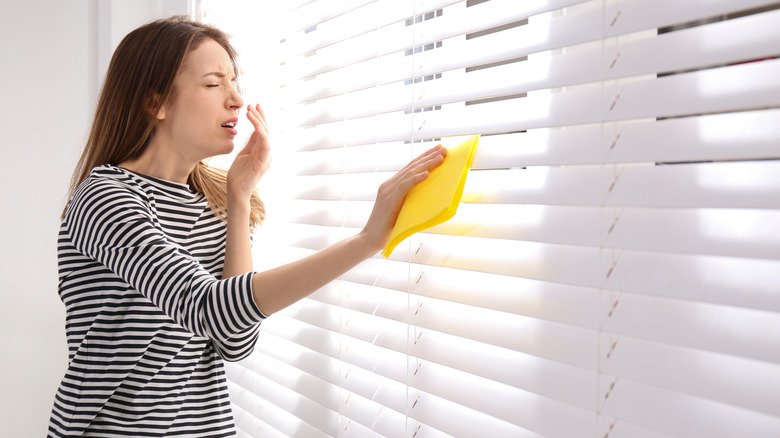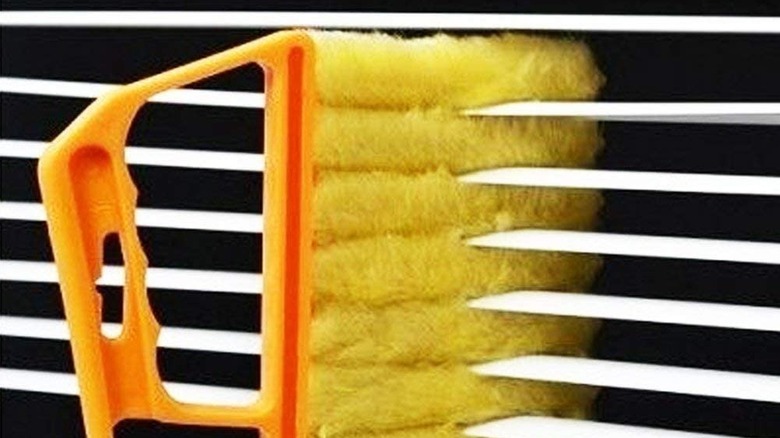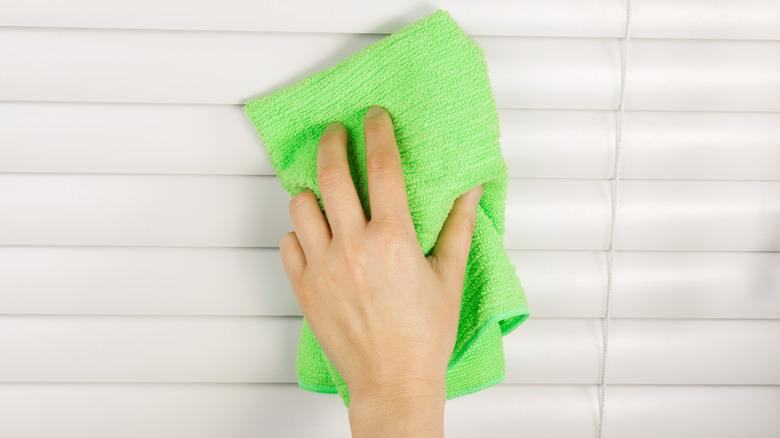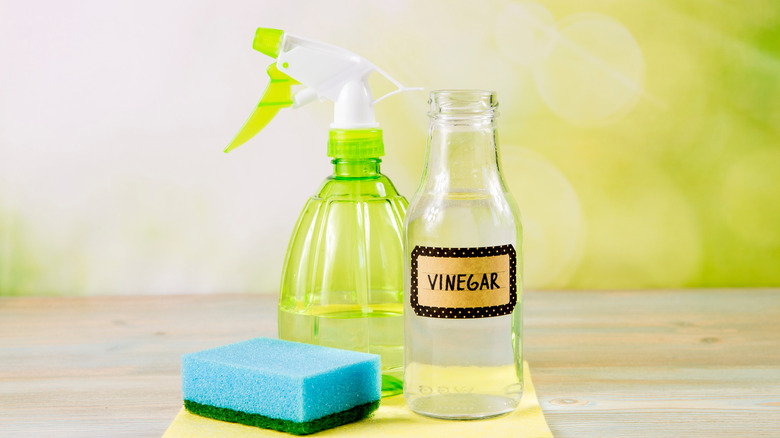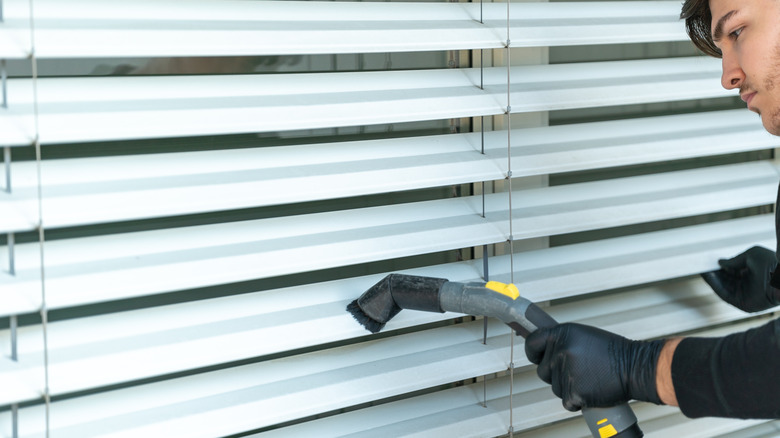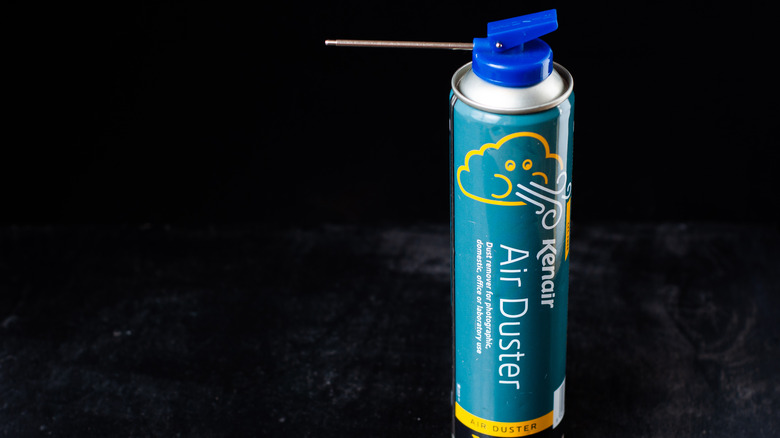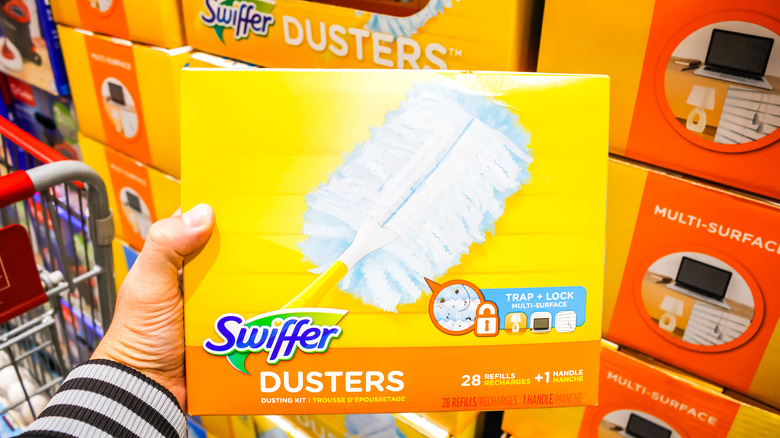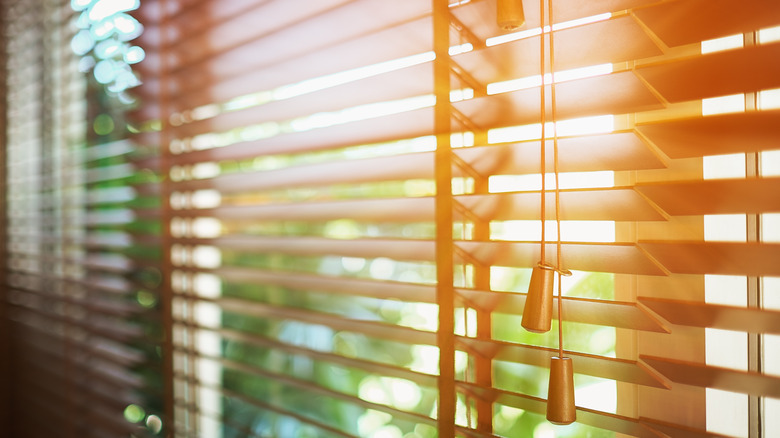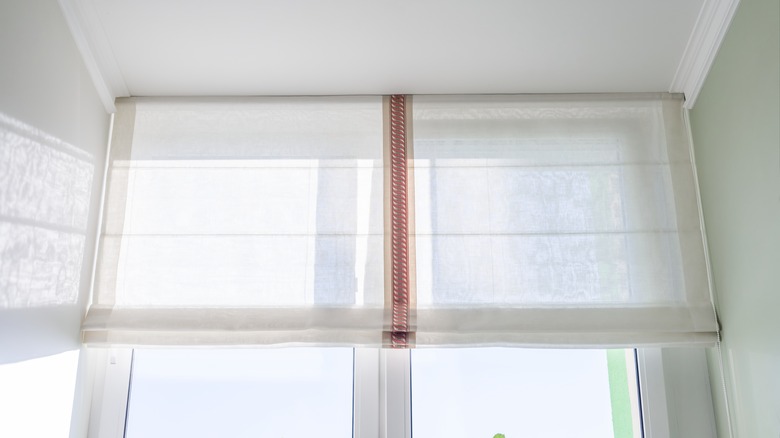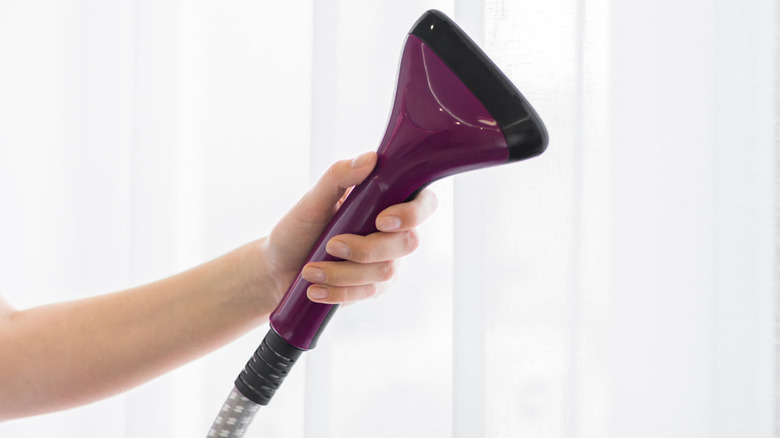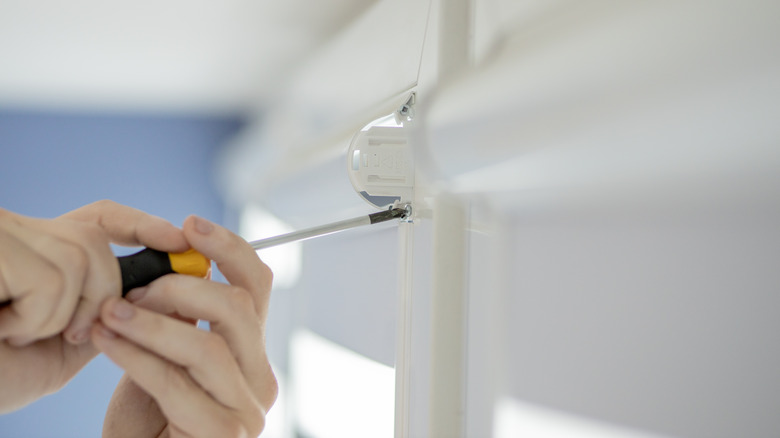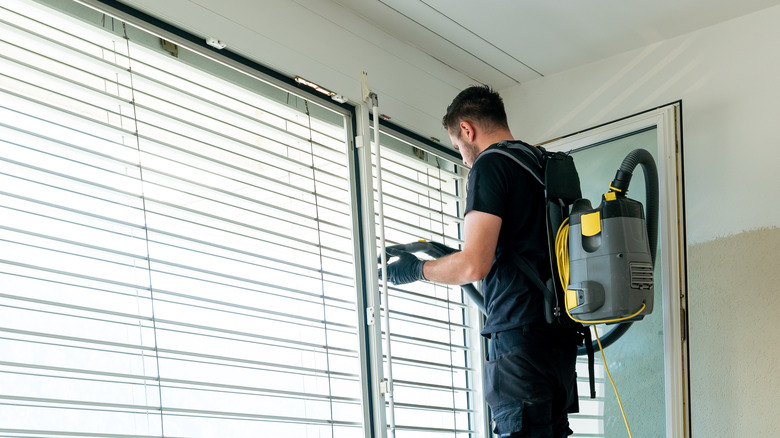The Easiest Ways To Clean Your Blinds
We may receive a commission on purchases made from links.
Whether you're worried about dusty blinds at home or faded, yellowing blinds at your office, cleaning them can feel like a big job and it's almost unavoidable. Although they're great for privacy and shade, blinds tend to be a hotspot for dust, dirt, and dander to gather. So, no matter if your blinds are vinyl, fabric, or wood, proper cleaning is a must.
Just like every other area of your house, there are a ton of methods and special tricks for cleaning blinds. You can choose from a myriad of specifically engineered products, miracle sprays, vacuum attachments, and creative dusting hacks. But they don't all work and not every method is easy. However, there are quite a few methods that are tried and true. The best part is that they don't involve tedious scrubbing or countless hours of work. Find the perfect method that works for you and your budget and you can mark this task off your to-do list.
Use a blind cleaner brush
In a world of innovation and technology, nearly every task around the home has a hack or a special product that you can try, and cleaning your blinds is no different. Cleaning individual panels of vinyl probably doesn't seem like a huge inconvenience. However, that can change if you have a house full of windows and a busy schedule. One of the easiest methods for cleaning your blinds is to use a blind cleaner brush.
This may sound like a no-brainer, but there are quite a few to choose from. One of the best brushes to use is the 7 Finger Dusting Tool that's available at Walmart or Amazon and just about any other store that sells cleaning supplies. The brush typically has a comfortable handle and several prongs that have removable dust-capturing material on them. The prongs fit between the vinyl panels and in one movement you can dust a whole section of your blinds. This can cut your dusting time in half and you can remove the soft covers and wash them for a simple cleanup.
Use a microfiber cloth
Another one of the easiest ways to clean your vinyl blinds is with a microfiber cloth. This method is also inexpensive and can be really effective if you're doing it about once per month. Be sure to use a microfiber cloth and not a cotton cloth. Microfiber is a synthetic material with fibers that are finer than cotton and much more absorbent. Compared to cotton it is also less breathable and can collect more dust. Microfiber also won't leave behind unwanted lint if the cloth is damp.
Start by closing your blinds all the way and pulling them down to cover the whole window. Wipe gently from top to bottom and side to side with the very slightly damp microfiber cloth. The next step is to reverse the blinds and close them all the way, so you are reaching both sides. Try to avoid sweeping excess dust into the air and think more about allowing the dust to absorb into the cloth. Once you clean both sides you can open them halfway and spot clean between any panels that are extra dusty. Be gentle and don't rush, breaking or snapping just one panel can be a pain to replace.
Use vinegar and water
Dusting with the help of a spray may already be a practiced habit or it may sound like an added step to an already tedious job. But, the problem with dust is that it's made up of very fine, small particles. These particles can travel far and fast and the slightest movement can set them sailing. Using a spray can help prevent dust from flying around the house and help it stick to your cloth or duster.
There is probably an entire shelf dedicated to dusting sprays and wipes in your local cleaning supply store. This makes it hard to choose which overpriced and over-marketed item to try. In addition, they are often loaded with harsh chemicals and can trigger allergies with added perfumes and fragrances. But there is an easy, at-home solution. Make your own cleaning spray with vinegar and water.
Grab a spray bottle of any size, and add three parts water and one part white vinegar. Give it a good shake and lightly spray your dusting cloth before wiping your blinds. You can directly spray your blinds as well if they are vinyl, but vinegar can be harsh on wood and the scent can linger in fabrics. You can also consider adding a few drops of essential oils to your dusting spray if you don't like the smell of regular vinegar.
Get the right vacuum attachment
Wiping down vinyl blinds with a cloth or duster is simple. The dust tends to lift easily and the surface is smooth enough that the job is quick. However, when it comes to wooden and fabric blinds, the build-up has more places to hide. The dust and dirt in your home can really settle into the grooves and weaves of these materials. Although some of these can often be removed and rinsed off, that isn't always the case. The best and safest way to get deep into the woven fabrics and textured wood is with a vacuum attachment.
Smaller attachments often come with your vacuum but you'll want to specifically invest in one that has bristles on the end. The brush will help dislodge stuck-on dust as you vacuum. Because you'll likely be vacuuming blinds that are still hanging you should opt for an attachment with softer bristles that will make the angle easier. Consider a wider attachment to make the job go faster and pull out a step stool to get hard-to-reach places. Work from top to bottom and be careful not to pull the blinds off the rod while you're trying to clean.
Try a compressed air duster
We've all seen those cans of compressed air that are meant to clear away the dust and dirt from your keyboard. The force of the air dislodges the dust and gets into very hard-to-reach areas. These convenient dusters can also be an easy way to clean between slats or around the blind strings and hardware.
With compressed air, the process is simple whether it's a disposable can or a rechargeable duster. Start from the top of your window and work your way down. Avoid blasting the blinds without a strategy or you'll disrupt the dust and let it settle again. Instead, aim the air downwards and work methodically from side to side and top to bottom. This will shoot the dust toward the floor where it can settle and you can vacuum it up.
If you're using a disposable can, be careful to keep enough distance to avoid bending and breaking vinyl blinds. Air may seem harmless but the blinds can be fragile. Rechargeable dusters tend to have higher and lower settings but a can of compressed air is not adjustable.
Use a Swiffer
Swiffer cleaning products are a trusted household name and for good reason. The dusting products specifically are designed to not only pick up dust but to trap particles. These are great at capturing dust because they are made of thousands of tiny, fluffy fibers that are coated with Dust Lock Adhesive™. These fibers are soft and extremely flexible which makes them easy to get into small spaces, like between vinyl blinds. A regular Swiffer will make quick work of dusting. However, the 360-degree duster will clean the top and bottom of the blinds, making it even faster. You can also be less precise with how you're dusting because a Swiffer will snatch up dust from the blinds but also trap dust in the air while you're dusting.
Another Swiffer product uses the same dust-trapping technology but it has an extendable handle. This tool will make it even easier to dust all of your window blinds from the ground. The best part about Swiffer dusters is that you can buy replacement covers and keep the handle for long-time use.
Reverse yellowing with bleach
Is there anything more unsightly than yellowing vinyl blinds? Nothing really gives your house a more dated look than discolored window treatments that are meant to be crisp and white. The truth about discoloring is that it occurs with sunlight and is hard to avoid over time. The UV rays and heat that are constantly beating down on your windows for years and years can begin to break down the surface of the blinds and give them that aged look. Rather than buying new blinds, you can try reversing the yellowing.
Of course, cleaning blinds that have yellowed is easier if you catch the problem early. Consider this method when you first start to notice the discoloring. Grab gloves and a microfiber cloth before creating a mixture of bleach and water in a spray bottle. Mix three parts water and one part bleach and spray your cloth to dampen it. Be mindful of dripping and wipe each blind down with the cloth. You may have to repeat this process depending on how yellow the blinds are, but if you are consistently using this method over the years you can stop yellowing in its tracks. You can also soak the blinds in a similar bleach mixture but this is a more involved process that could be used if the blinds are very badly yellowed.
Use an upholstery cleaner for stains on cloth blinds
Mishaps can occur in any home. You can slip with a cup of coffee sending splashes airborne or little fingers can find their way to your window treatments. You might think stains on your roman blinds are entirely unlikely. But it's bound to happen and an upholstery cleaner will save the day.
For small stains spot cleaning is an easy solution. Choose an upholstery cleaner that is gentle on fabrics and won't stain or dye your fabric blinds. Be sure to check the tag for the type of fabric and cleaning instructions. A spray bottle will make hard-to-reach spots more accessible and you won't have to take the blinds down. Or, if the stains are large, you can spot clean and let them soak before tossing them in the washer per the instructions.
Probiotic Carpet & Upholstery Cleaner by Nookary is an excellent choice to have on hand. This non-toxic spray is gentle, but effective and comes as a concentrate that can be diluted to your unique needs. You can make a more concentrated spray with less water, spray the stain, allow it to sit for five to ten minutes, and then wipe it away with a damp microfiber cloth. If the stain is persistent, try applying another round of spray or letting it soak in for longer.
Use a steam cleaner
If you have a larger, more resistant stain on your roman or other fabric blinds, consider renting, buying, or borrowing a hand steamer to clean them. Certain fabrics that are used to make blinds, such as cotton, can firmly hold dirt and moisture and become the perfect setting for mold or bacteria to grow. Because blinds are near windows and doors they can often become damp with condensation or from the outside elements when they are open. To combat stains or lurking bacteria use a steam cleaner.
Steam cleaners employ hot water and some cleaning solution. In the machine, the water is heated, turned into vapors, and then funneled through a nozzle to target stains and specific areas. The steam loosens the fibers and the dirt so it can easily be vacuumed away. Be sure to check the label of the unit to see what cleaning solutions are appropriate. Use a step stool to safely reach higher areas and be careful not to pull on the fabric. In addition, always be cautious with steam cleaners as the water can get very hot and burn you.
Avoid spot cleaning with this method. You may not notice how discolored your roman blinds are until you clean a single spot and compare it to the rest of the fabric. Once again, begin at the top and slowly work your way down to the bottom of the blind.
The bathtub method
The bathtub method is not recommended for everyday dusting or cleaning and works best with vinyl blinds. This more involved tactic is for blinds that are long overdue for a cleaning or have serious stains that can't be wiped away or would be too time-consuming to do so. Soaking your blinds is straightforward and there is a myriad of cleaning products that will remove dirt and grime without scrubbing. Fill your tub with warm to hot water, and stir in a few tablespoons of dish detergent, dish soap, vinegar, or some other type of multi-purpose cleaner.
Then, carefully remove the blinds from your windows and place them in the solution, allowing them to soak and for the grime to break down. Try to avoid getting any metal parts or hardware wet or rusting could occur. If the metal does get wet, dry it quickly. Ten to thirty minutes should be enough time to break down most stains. However, if you are using bleach only allow them to soak for ten minutes. You can apply some gentle scrubbing or wipe down areas that are particularly stained, but be careful not to twist or bend the panels while removing or soaking them. Allow the blinds to lay flat on a towel or sheet to dry. Make sure none of the blades are bent and consider applying a dust-resistant spray after they are dry before rehanging them.
Hire a professional
What is the easiest method of all? Hire a professional to clean your blinds for you. This is not the most cost-effective method but it does take the hassle out of the task. When hiring a professional to clean your blinds you should always get an estimate. Give them a clear description of what type of blinds are in your home and disclose any larger stains or problem areas before they arrive. If you prepare the team then they can show up with the appropriate tools to get the job done. Also, get an accurate estimate of how many windows are in your home and how big they are. Underestimating could result in an unexpected upcharge.
Once you get a quote, compare prices, look online for positive or negative reviews, and don't forget to ask about their cleaners. Different companies use different cleaning solutions. Ask about non-toxic options, fragrance-free or different scents available, and don't forget to mention any allergies. It's not always required, but you should try and clear a path to your windows that are going to be cleaned. Move any large furniture pieces so the technician can easily reach your blinds and work efficiently.
